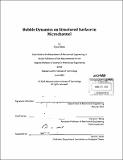Bubble dynamics on structured surface in microchannel
Author(s)
Chen, Siyu (Scientist in civil and environmental engineering)
DownloadFull printable version (12.21Mb)
Other Contributors
Massachusetts Institute of Technology. Department of Mechanical Engineering.
Advisor
Evelyn N. Wang.
Terms of use
Metadata
Show full item recordAbstract
Surface enhancement is a potential way to improve the performance of flow boiling in microchannels, which is considered to be one of the most promising cooling methods to solve thermal management challenges faced by future semiconductor products. Considerable research has been done on examining the functions of engineered surfaces. However, the mechanism of how these surfaces improve the flow boiling performance is still unclear. In this thesis, bubble dynamics on micropillar array surfaces were studied. A surface energy based model is presented to predict the bubble morphology on pillar array surfaces. The results showed that bubbles tend to stay on top surfaces of pillars at solid fractions greater than 0.162, keeping liquid films underneath the bubbles. On the other hand, on surfaces at solid fraction less than 0.162, bubbles tend to propagate within the pillar unit cells. A flow loop with good degassing and a fluid temperature control system was designed and built for various flow boiling experiments. Five different types of silicon micropillar array surfaces were fabricated. Moreover a setup for observing bubble dynamics in microchannels under flow boiling conditions was developed. Experiments were performed to investigate the bubble dynamics on silicon micropillar array surfaces. Bubble departure modes were observed. The bubble departure size of direct departing mode was found to be independent with flow rate while departure size of sliding mode decreased with increasing of the flow rate. Three potential methods to create single nucleation sites for improved studies of bubble dynamics were also presented in this thesis. An experimental setup to investigate behavior of a single bubbles created by air injection on micropillar array was presented. Single 10-30 [mu]m injection holes were fabricated on micropillar array surfaces by laser cutter. The experimental results show that structured surfaces have higher bubble departure sizes than that for a plain surface. The surfaces with solid fractions greater than 0.162 had larger departure sizes than that of surfaces with solid fractions smaller than 0.162 at mass flow rates above 250 kg/m²s while departure sizes of the higher solid fraction surfaces become smaller than that of lower solid fraction surfaces when flow rates decreased below 200 kg/m²s. The similarity between the departure sizes obtained by air injection experiments and flow boiling experiments suggest that air injection experiments could provide useful information on understanding the vapor bubble departure behavior on micropillar array surfaces. Silicon micropillar array surfaces may have larger bubble departure sizes than plain surfaces, however, the surfaces with solid fractions greater than 0.162 are suggested for boiling due the a large amount of liquid thin films may create for higher heat transfer rates.
Description
Thesis (S.M.)--Massachusetts Institute of Technology, Dept. of Mechanical Engineering, 2013. Cataloged from PDF version of thesis. Includes bibliographical references (p. 69-70).
Date issued
2013Department
Massachusetts Institute of Technology. Department of Mechanical EngineeringPublisher
Massachusetts Institute of Technology
Keywords
Mechanical Engineering.